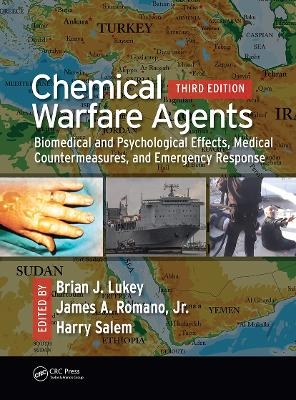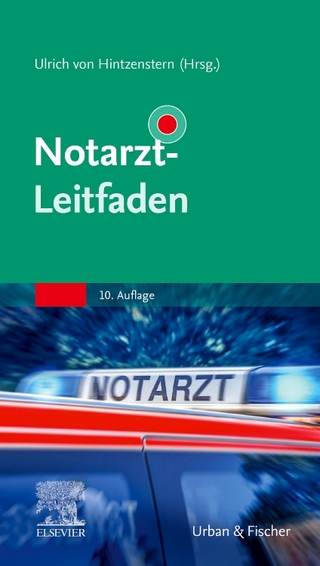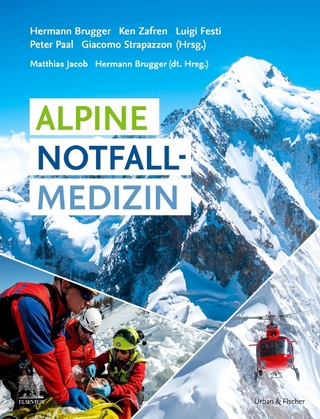
Chemical Warfare Agents
Crc Press Inc (Verlag)
978-1-4987-6921-1 (ISBN)
The first edition of this book, Chemical Warfare Agents: Toxicity at Low Levels, was published just prior to the terrorist attacks of September 11, 2001. The second edition titled, Chemical Warfare Agents: Pharmacology, Toxicology, and Therapeutics, included new epidemiological and clinical studies of exposed or potentially exposed populations; new treatment concepts and products; improved organization of the national response apparatus addressing the potential for CWA terrorism; and improved diagnostic tests that enable rapid diagnosis and treatment.
Since the second edition, the chemical warfare agent community has worked hard to advance research for protection and treatment and develop/improve response approaches for individuals and definitive care. Consequently, in addition to updating previous chapters, Chemical Warfare Agents: Biomedical and Psychological Effects, Medical Countermeasures, and Emergency Response, Third Edition features several new chapters that address the Syrian War, chemical destruction, the Organisation for the Prohibition of Chemical Weapons, biomarkers for chemical warfare agent exposure, field sensors, aircraft decontamination, lung/human on a chip, chemical warfare response decision making, and other research advancements.
Features:
Describes the newest medical interventions, and the latest technologies deployed in the field, as well as developments in the international response to CW usage highlighting recent events in the Middle East
Discusses the latest in organizational/interagency partitioning in terms of responsibilities for emergency response, not just in the United States but at the international level—whether prevention, mitigation, medical care, reclamation, or medico-legal aspects of such response
Contains the most current research from bench-level experts
The third edition contains the most up-to-date and comprehensive coverage of the question of chemical warfare agent employment on the battlefield or in terrorism. Edited by workers that have been in the field for 35+ years, it remains faithful to the scientific "constants," while evaluating and crediting the advances by the industry that have made us safer.
Col (retired) Brian J. Lukey, PhD, is currently a senior civilian toxicologist for the U.S. Air Force, Wright-Patterson Air Force Base. James A. Romano, Jr., PhD, was an instructor of psychology at Manhattan College, Bronx, New York, from 1970 to 1975. He currently serves on the Homeland Security Subcommittee to the Environmental Protection Agency’s Board of Scientific Counselors. Harry Salem, PhD, is chief scientist for Life Sciences at the U.S. Army Edgewood Chemical Biological Center, Aberdeen Proving Ground, Maryland. Edgewood Chemical Biological Center is a U.S. Army Research, Development, and Engineering Command Laboratory and is the Army’s principal research and development center for chemical and biological defense technology, engineering, and field operations.
Section I: General. 1. Brief History and Use of Chemical Warfare Agents in Warfare and Terrorism. 2. Chemistries of Chemical Warfare Agents. 3. Toxicokinetics of Nerve Agents. 4. Organization for the Prohibition of Chemical Weapons (OPCW): History, Mission, and Accomplishments. 5. Chemical Holdings and Their Internationally Verified Destruction. 6. Syria's Chemical Disposal Program. 7. The Use of Chemical Warfare Agents during the Syrian Civil War. 8. U.S. CBRN Homeland Response and Civil Support. Section II: Agent Effects. 9. Mustard Vesicants. 10. Health and Psychological Effects of Low-Level Exposure to Chemical Warfare Nerve Agents. 11. Inhalation Toxicology of Chemical Agents. 12. Cyanides: Toxicology, Clinical Presentation, and Medical Management. 13. The Structural Biology, Biochemistry, Toxicology, and Military Use of the Ricin Toxin and the Associated Treatments and Medical Countermeasures for Ricin Exposure. 14. Medical Countermeasures for Intoxication by Botulinum Neurotoxin. 15. Incapacitating Agents and Technologies: A Review. 16. Screening Smokes: Applications, Toxicology, Clinical Considerations, and Medical Management. Section III: Protection. 17. Personal Protective Equipment (PPE): Practical and Theoretical Considerations. 18. Pyridostigmine Protection from Nerve Agent Intoxication: Concept to FDA Approval. 19. Hormesis: Using Preconditioning to Build Biological Shields - A Novel Approach for Enhancing Resilience to Toxic Agents, Traumatic Illness/Injury, and Age-Related Degenerative Diseases. Section IV: Detection. 20. Clinical Detection of Exposure to Chemical Warfare Agents. 21. Biomarkers for Organophosphate Poisoning: Physiological and Pathological Responses. 22. Field Sensors: Military and Civilian. 23. Application of Genomic, Proteomic, and Metabolomic Technologies to the Development of Countermeasures against Chemical Warfare Agents. 24. Nanomaterial-Based Sensors: Applications in Chemical Warfare Agent Detection and Identification. Section V: Decontamination. 25. Chemical Warfare Agent Decontamination from Skin. 26. Aircraft Decontamination and Mitigation. Section VI: Treatment. 27. Military Chemical Casualty Treatment. 28. Pre-Hospital and Hospital Response to Toxicological Mass Casualty Events: The Israeli Approach. 29. An Overview of the NIAID/NIH Chemical Medical Countermeasures Product Research and Development Program. 30. Medical Management of Chemical Warfare Agents. 31. Protein-Based Bioscavengers of Organophosphorus Nerve Agents. 32. Oxime Research. 33. Brain-Penetrating Reactivators of Organophosphate-Inhibited Acetylcholinesterase. 34. Nerve Agent-Induced Seizures and Status Epilepticus: Neuroprotective Strategies. Section VII: Predictive Modeling. 35. Computational Modeling to Predict Human Toxcitiy. 36. Lung-on-a-Chip. 37. Body-on-a-Chip for Pharmacology and Toxicology. 38. Animal Models. 39. Real-Time Physiological Data Collection and Analysis in Animal Inhalation Models: Predictive and Diagnostic Implications. 40. Contextual Factors Influencing Leadership Decision Making.
| Erscheinungsdatum | 09.05.2019 |
|---|---|
| Zusatzinfo | 82 Illustrations, color; 146 Illustrations, black and white |
| Verlagsort | Bosa Roca |
| Sprache | englisch |
| Maße | 210 x 280 mm |
| Gewicht | 2540 g |
| Themenwelt | Medizin / Pharmazie ► Allgemeines / Lexika |
| Medizin / Pharmazie ► Medizinische Fachgebiete ► Notfallmedizin | |
| Sozialwissenschaften ► Politik / Verwaltung ► Europäische / Internationale Politik | |
| ISBN-10 | 1-4987-6921-7 / 1498769217 |
| ISBN-13 | 978-1-4987-6921-1 / 9781498769211 |
| Zustand | Neuware |
| Haben Sie eine Frage zum Produkt? |
aus dem Bereich


